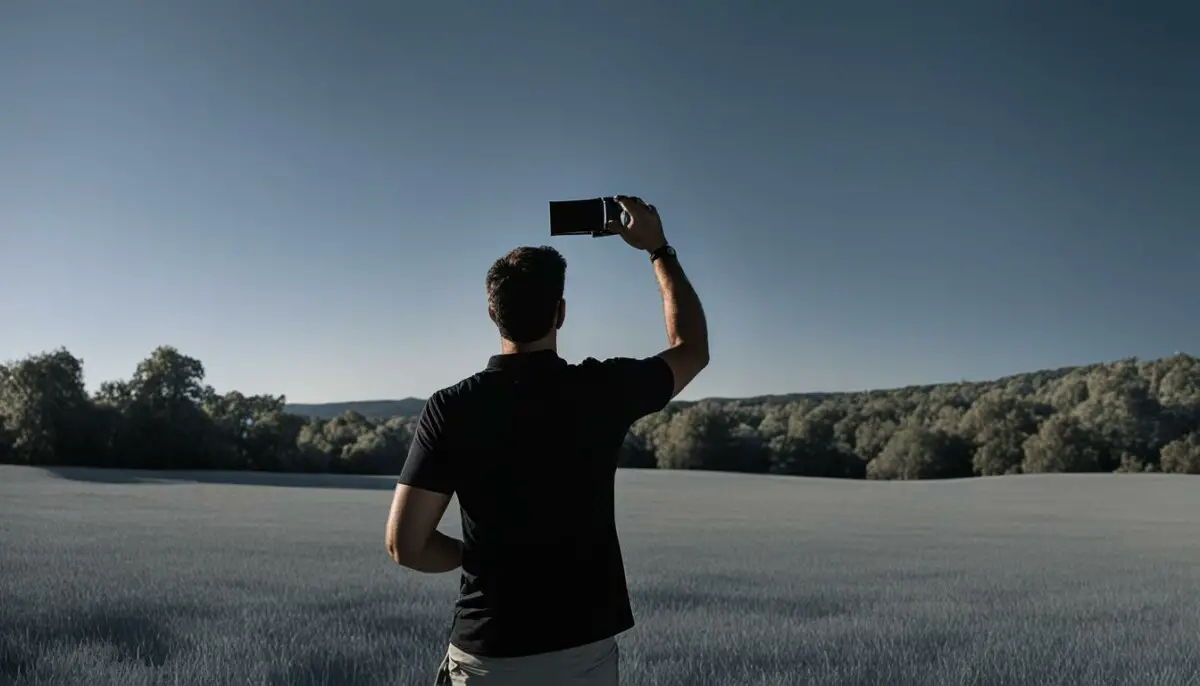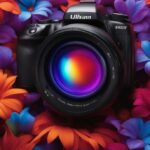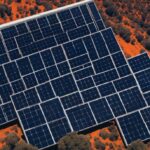Last Updated on 4 months by Francis
When it comes to viewing a solar eclipse, many people wonder if they can use an infrared filter to watch the event safely. It is important to understand that while infrared filters can block out visible light and protect your eyes from harmful rays, they are not specifically designed for viewing a solar eclipse. In order to safely observe an eclipse, it is recommended to use a solar filter that meets the ISO 12312-2 safety standard. Solar filters are specifically designed to block out harmful ultraviolet and infrared rays, providing a safe viewing experience. It is always important to prioritize safety when observing a solar eclipse.
Contents
Key Takeaways:
- Infrared filters are not specifically designed for viewing a solar eclipse.
- To safely observe an eclipse, use a solar filter that meets the ISO 12312-2 safety standard.
- Solar filters block out harmful ultraviolet and infrared rays, ensuring a safe viewing experience.
- Always prioritize safety when observing a solar eclipse.
The Importance of Using a Solar Filter
When it comes to viewing a solar eclipse, the safety of your eyes should be your top priority. Directly looking at the sun during an eclipse can cause permanent eye damage. That’s why using a solar filter specifically designed for solar viewing is crucial.
Solar filters are designed to block out harmful ultraviolet and infrared rays, providing a safe way to observe the sun during an eclipse. By using a proper solar filter, you can enhance your eclipse viewing experience while protecting your eyes from the sun’s damaging rays.
When choosing a solar filter, it is important to select one that meets the ISO 12312-2 safety standard. This standard ensures that the filter will block out 99.99% of the sun’s visible and ultraviolet light, offering maximum protection for your eyes.
So, why is using a solar filter so important? Let’s take a closer look at the benefits:
- Eye Protection: Solar filters block out harmful ultraviolet and infrared rays, safeguarding your eyes from potential damage.
- Safe Viewing: By using a solar filter, you can safely observe the sun during an eclipse, allowing you to witness this incredible natural phenomenon without putting your eyes at risk.
- Enhanced Experience: A solar filter provides clear visibility of the sun’s features and allows you to see details such as sunspots, solar flares, and the sun’s corona during totality.
To illustrate the effectiveness of a solar filter, here is a comparison table showcasing the key benefits:
| Benefits of Using a Solar Filter | Benefits of Not Using a Solar Filter | |
|---|---|---|
| Eye Protection | Blocks harmful ultraviolet and infrared rays, ensuring eye safety | Exposes your eyes to intense sunlight, risking permanent eye damage |
| Safe Viewing | Allows safe observation of the sun during an eclipse | Directly looking at the sun can cause permanent eye injury |
| Enhanced Experience | Clear visibility of the sun’s features and details | Difficulty in observing sunspots, solar flares, and the sun’s corona |
As you can see, using a solar filter provides significant advantages for eclipse viewing. Remember to always prioritize your eye safety and choose a solar filter that complies with the ISO 12312-2 safety standard. By doing so, you can enjoy the awe-inspiring beauty of a solar eclipse without jeopardizing your vision.
Different Types of Lens Filters
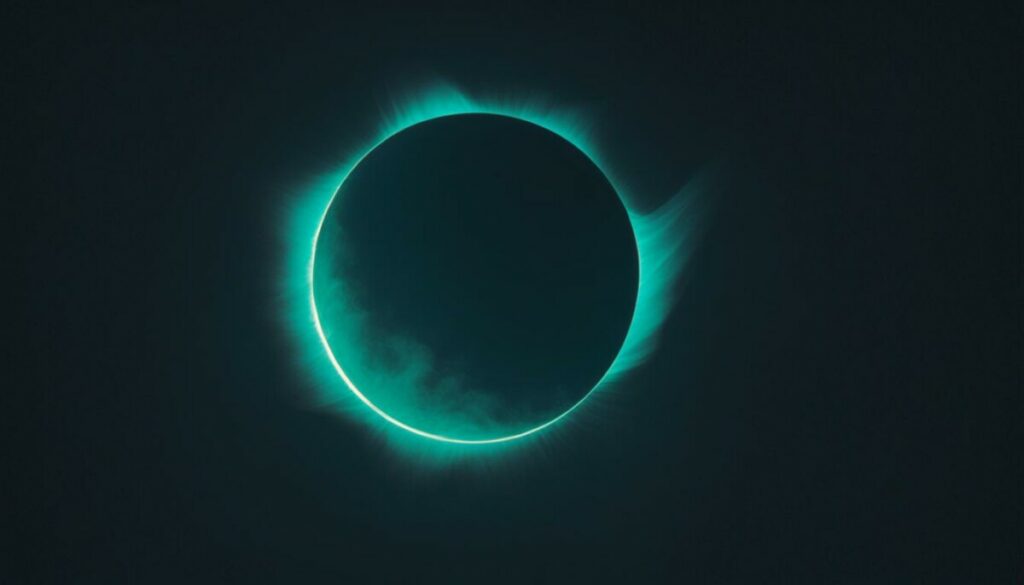
When it comes to photography, different types of lens filters are widely used to enhance the quality and visual effects of images. These filters serve various purposes such as controlling exposure, reducing glare, and improving image clarity. However, not all lens filters are suitable for viewing solar eclipses. Let’s take a closer look at some commonly used filters and their applicability to eclipse viewing.
Neutral Density Filters
Neutral density (ND) filters are designed to reduce the amount of light that enters the camera lens without altering the color or contrast of the image. They come in different strengths, allowing photographers to achieve long exposures or use wider apertures in bright lighting conditions. While ND filters can be useful for creative photography, they are not specifically designed for eclipse viewing and do not protect against harmful rays.
Polarizing Filters
Polarizing filters are commonly used to reduce glare and reflections from non-metallic surfaces such as water or glass. They can enhance color saturation and contrast, resulting in more vivid and detailed images. However, like neutral density filters, polarizing filters are not suitable for viewing solar eclipses and do not provide the necessary protection against harmful rays.
Infrared Filters
Infrared (IR) filters are designed to block out visible light and only allow infrared light to pass through. These filters can be used for specific photography purposes, such as capturing unique landscapes or creating artistic effects. While infrared filters may provide some protection from harmful rays, they are not recommended for viewing a solar eclipse. In order to safely observe an eclipse, it is crucial to use solar filters that meet the ISO 12312-2 safety standard.
Infrared filters block out visible light and only allow infrared light to pass through. While they may provide some protection from harmful rays, they are not recommended for viewing a solar eclipse. It is crucial to use solar filters that meet the ISO 12312-2 safety standard for a safe and enjoyable eclipse viewing experience.
Table: Comparing Different Lens Filters for Eclipse Viewing
| Filter Type | Applicability to Eclipse Viewing | Level of Protection |
|---|---|---|
| Neutral Density Filters | Not recommended | No protection against harmful rays |
| Polarizing Filters | Not recommended | No protection against harmful rays |
| Infrared Filters | Not recommended | Some protection, but not sufficient |
| Solar Filters (ISO 12312-2 compliant) | Recommended | Provides safe viewing experience |
The table above illustrates the suitability of different lens filters for eclipse viewing. While neutral density, polarizing, and infrared filters have their uses in photography, they are not designed to protect against harmful rays during a solar eclipse. For a safe and enjoyable eclipse viewing experience, it is essential to use solar filters that meet the ISO 12312-2 safety standard.
The ISO 12312-2 Safety Standard
The ISO 12312-2 safety standard is an international safety standard for filters for direct viewing of the sun. Solar filters that meet this standard are specifically designed to block out harmful ultraviolet and infrared rays while allowing safe viewing of the sun during an eclipse. It is important to look for solar filters that comply with this safety standard to ensure their effectiveness and safety. Using filters that meet the ISO 12312-2 safety standard provides peace of mind and ensures a safe viewing experience during a solar eclipse.
Proper Precautions When Viewing a Solar Eclipse
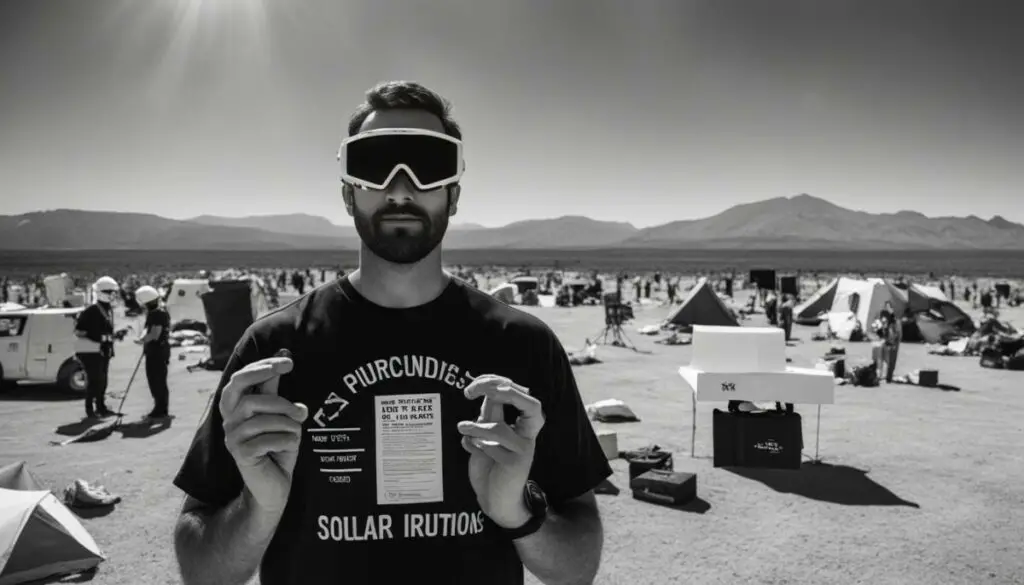
When it comes to viewing a solar eclipse, taking proper safety precautions is crucial to protect your eyes and ensure a safe experience. Looking directly at the sun, even during an eclipse, can cause permanent eye damage. Therefore, it is essential to follow these guidelines to safeguard your eyes and fully enjoy the spectacle.
1. Never look directly at the sun without proper eye protection
It is of utmost importance to avoid looking directly at the sun without the appropriate eye protection, even during an eclipse. Homemade filters or regular sunglasses are not sufficient to block out the harmful rays of the sun. Always use certified solar filters or eclipse glasses that meet the ISO 12312-2 safety standard.
2. Use certified solar filters or eclipse glasses
Solar filters and eclipse glasses that adhere to the ISO 12312-2 safety standard are specially designed to block out harmful ultraviolet and infrared rays, ensuring your eyes are adequately protected. These filters provide the necessary protection for safe eclipse viewing.
3. Avoid removing the filter or looking at the sun through your camera’s viewfinder
Never remove the solar filter or attempt to look at the sun through your camera’s viewfinder without a proper solar filter. Doing so can expose your eyes to the harmful rays of the sun and potentially cause irreversible damage. Always prioritize eye safety and use the appropriate precautions.
4. Follow the ISO 12312-2 safety standard
Adhering to the ISO 12312-2 safety standard ensures that you are using reliable and effective solar filters or eclipse glasses. This standard guarantees that the filters meet the necessary criteria for blocking out harmful ultraviolet and infrared rays, offering peace of mind and ensuring a safe viewing experience.
By following these proper safety guidelines, you can enjoy the awe-inspiring wonder of a solar eclipse while protecting your eyes from potential dangers. Remember, safety should always be the top priority when viewing a solar eclipse.
Recommendations for Eclipse Photography
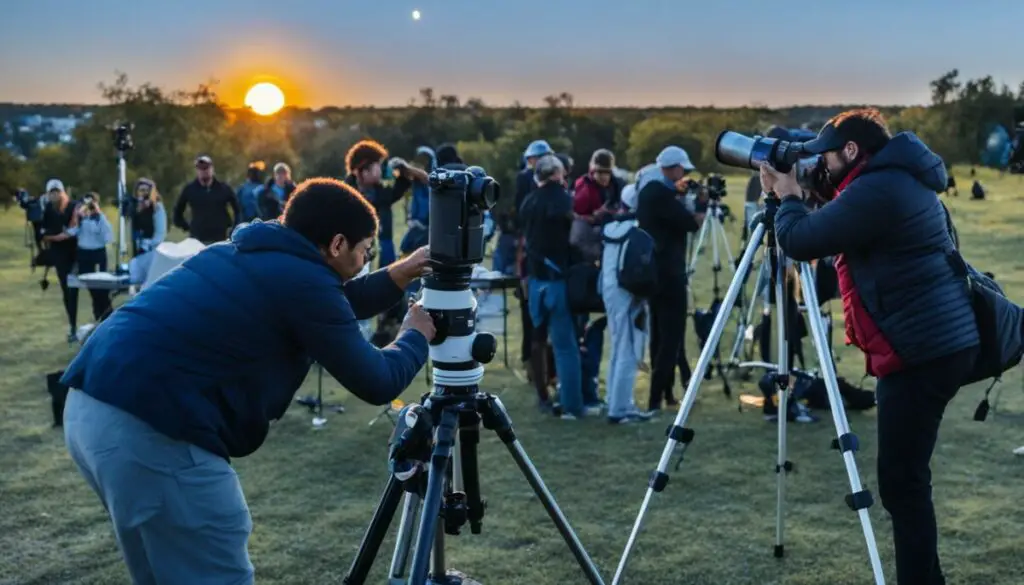
If you are interested in photographing a solar eclipse, there are several tips and techniques that can help you capture stunning images of this awe-inspiring event. Whether you’re aiming to document the entire eclipse or focus on capturing the corona and prominences, here are some recommendations to enhance your photography:
- Use proper equipment: Invest in a high-quality DSLR camera with manual settings and interchangeable lenses. A telephoto lens with a focal length between 200-400mm is ideal for capturing the details of the eclipse.
- Protect your eyes and camera: During the partial phases of the eclipse, always use a solar filter to protect your camera and your eyes from the intense sunlight. Remove the filter only during totality, when the moon completely blocks the sun.
- Adjust your exposure settings: To capture the corona, set your camera to a long exposure time of several seconds. For capturing the prominences, use faster exposure settings ranging from 1/100 to 1/200 of a second.
- Use an automated exposure ramping script: To ensure proper exposure as the lighting conditions change rapidly during the eclipse, consider using an automated exposure ramping script. This will help you capture the subtle details of the corona and prominences.
- Keep your camera steady: To avoid camera shake and capture sharp images, use a sturdy tripod. Securely mount your camera and lens to the tripod and avoid touching the setup during the exposure.
By following these recommendations and combining them with your creative eye, you can capture breathtaking photos of a solar eclipse. Remember, always prioritize your safety and protect your eyes and equipment with the appropriate filters and precautions.
Capturing the Corona and Prominences
“The corona is the outermost layer of the sun’s atmosphere, and prominences are giant loops of superheated gas that erupt from the surface of the sun. During a total solar eclipse, these celestial phenomena become visible.”– NASA
During totality, when the moon completely blocks the sun, you have the opportunity to capture the ethereal corona and the majestic prominences. Remove your solar filter and use your camera’s long exposure settings to capture the delicate details of the corona. Experiment with different exposure times to achieve the desired effect.
Keep in mind that the corona has a wide range of brightness, so it’s important to find the right balance. A good starting point is to set your camera’s ISO to a low value (around 100-400) and adjust the aperture to a medium setting (f/8 to f/11). From there, adjust the exposure time to capture the intricate patterns and faint details of the corona.
For the prominences, faster exposure settings of 1/100 to 1/200 of a second are recommended. These shorter exposure times will help you freeze the motion of the erupting gas and capture their unique shapes and structures.
| Recommended Exposure Settings | Aperture | ISO | Exposure Time |
|---|---|---|---|
| Corona | f/8 to f/11 | 100-400 | Several seconds |
| Prominences | f/8 to f/11 | 100-400 | 1/100 to 1/200 seconds |
Remember to consult your camera’s manual for specific instructions on adjusting these settings and experiment with different combinations to achieve the desired results.
With careful preparation, the right equipment, and a little bit of creativity, capturing the corona and prominences during a solar eclipse can result in awe-inspiring photographs that will be cherished for a lifetime.
Avoid Counterfeit or Unsafe Filters
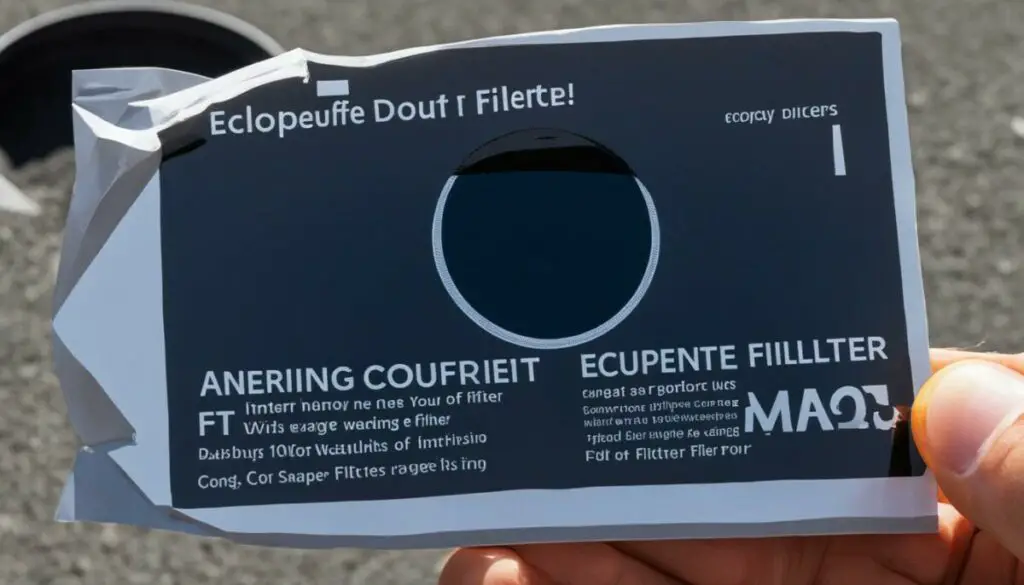
In recent years, there has been an alarming increase in the availability of counterfeit eclipse glasses and filters in the market. These counterfeit products are often labeled as ISO-compliant but have not undergone proper safety testing. Using such filters can pose serious risks to your eyes and may compromise your ability to safely view an eclipse.
To ensure your safety and the effectiveness of the filter, it is imperative to purchase from reputable solar filter suppliers who provide genuine and certified products. One reliable source of information is the American Astronomical Society (AAS) website, where you can find a list of reputable suppliers that meet the ISO 12312-2 safety standard for solar filters.
When purchasing solar filters, exercise caution and be skeptical of vendors who claim compliance without proper accreditation. These unauthorized filters may not provide adequate protection and can increase the likelihood of eye damage during eclipse viewing.
| Benefits of buying from reputable suppliers: | Risks associated with counterfeit filters: |
|---|---|
|
|
By purchasing from reputable suppliers, you can avoid counterfeit or unsafe filters and prioritize your safety during eclipse observation. Remember, your eyes are precious, and using genuine and certified solar filters is essential to ensure a safe and enjoyable viewing experience.
The Importance of Proper Filter Maintenance
Proper maintenance of solar filters is crucial to ensure their effectiveness and longevity. By regularly inspecting your filters for signs of wear and damage, you can ensure a safe and optimal viewing experience during solar eclipses.
Here are some key maintenance tips to keep in mind:
Inspect Filters Regularly
- Check for tears, scratches, or punctures in the filter material.
- If any damage is found, immediately replace the filter to prevent any potential harm to your eyes.
Secure Attachment
- Make sure your filters are securely attached to your camera or telescope to avoid accidental removal during observation.
- A loose filter can compromise the safety of your eyes and the quality of your viewing experience.
Proper Storage
- Store your filters in a safe and clean place to protect them from scratches or damage.
- Avoid exposing them to excessive heat, moisture, or direct sunlight, as these conditions may degrade the filter material over time.
Regular maintenance and proper care of your filters will help ensure their reliability and longevity, allowing you to safely observe future solar eclipses without compromising your vision.
| Benefits of Proper Filter Maintenance | Consequences of Neglecting Filter Maintenance |
|---|---|
|
|
|
Conclusion
In conclusion, when it comes to safely observing a solar eclipse, it is crucial to prioritize your eye safety. While infrared filters may have their uses in photography, they are not recommended for eclipse viewing. To ensure a safe experience, it is important to use solar filters that meet the ISO 12312-2 safety standard. These specialized filters are designed to block out harmful ultraviolet and infrared rays, providing optimal protection for your eyes during an eclipse.
Always adhere to proper safety guidelines when observing a solar eclipse and never compromise on eye protection. Avoid taking shortcuts and rely on certified solar filters for a responsible eclipse observing experience. By utilizing these filters and following the recommended safety precautions, you can fully immerse yourself in the captivating beauty of a solar eclipse while safeguarding your vision.
Remember, the journey of witnessing a solar eclipse should be both awe-inspiring and safe. Don’t take any chances with your eye health. Embrace the magic of this celestial event while taking the necessary precautions with infrared filters for safe eclipse observation and responsible eclipse observing with solar filters.
FAQ
Can I use an infrared filter to watch the eclipse?
No, infrared filters are not specifically designed for viewing a solar eclipse. It is recommended to use a solar filter that meets the ISO 12312-2 safety standard for safe eclipse observing.
What is the importance of using a solar filter?
Solar filters block out harmful ultraviolet and infrared rays, providing a safe viewing experience during a solar eclipse.
Are there different types of lens filters for eclipse viewing?
Yes, there are various lens filters available, such as neutral density filters, polarizing filters, and infrared filters. However, solar filters that meet the ISO 12312-2 safety standard are specifically designed for eclipse visibility.
What is the ISO 12312-2 safety standard?
The ISO 12312-2 safety standard is an international safety standard for filters for direct viewing of the sun. Solar filters that meet this standard block out harmful ultraviolet and infrared rays while allowing safe solar viewing.
What precautions should I take when viewing a solar eclipse?
Always use certified solar filters or eclipse glasses that meet the ISO 12312-2 safety standard. Never look directly at the sun without proper eye protection and avoid removing the filter or using the viewfinder without a solar filter.
Do you have any recommendations for eclipse photography?
Use proper equipment and techniques, such as using a solar filter during the partial phases and removing it during totality to capture the corona and prominences. Use a tripod to avoid camera shake and consider using an automated exposure ramping script.
How can I ensure I am purchasing safe solar filters?
Purchase from reputable suppliers listed on the American Astronomical Society (AAS) website, as they have been verified to provide filters that meet the ISO 12312-2 safety standard.
How important is proper filter maintenance?
Proper maintenance of solar filters is crucial to ensure their effectiveness and longevity. Regularly inspect them for any signs of wear, securely attach them to your camera, and store them in a safe and clean place.
Is it safe to use infrared filters for eclipse observation?
No, infrared filters are not recommended for safely observing a solar eclipse. It is crucial to prioritize safety and use solar filters that meet the ISO 12312-2 safety standard.

